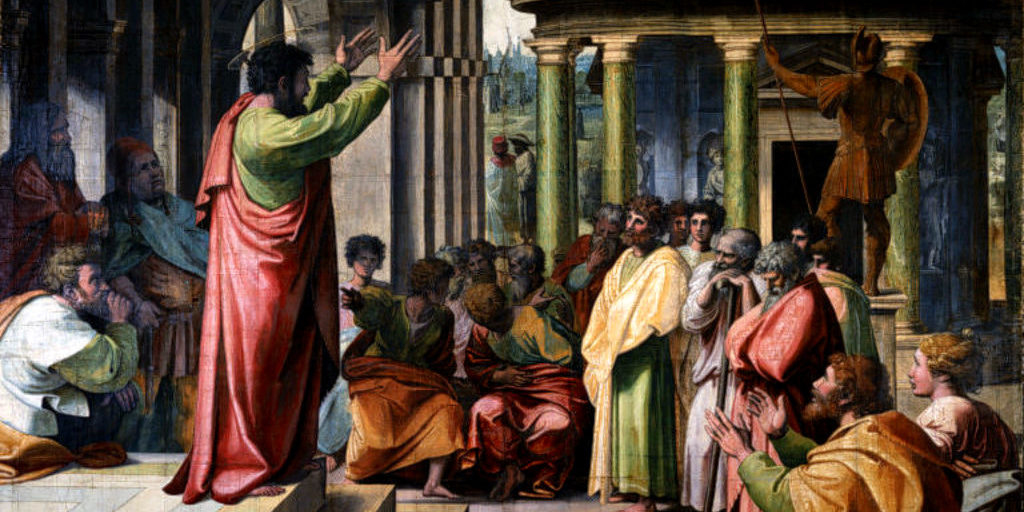
The Apostles and Sola Scriptura
We historic Protestants believe in Sola Scriptura—Scripture as the sole final authority for life and ministry.[1] But if that’s so, then the ultimate justification for our interpretative model and the theology it produces cannot be an idea or principle extraneous to the Bible.[2] Among other things, the ultimacy, and uniqueness of Scripture’s authority implies that Scripture itself must govern how we interpret it. Scripture acts not only as the sole authority for doctrine and life but for the interpretive practices that shape the ways we arrive at that doctrine as we study Scripture.
But the Bible does not have a book entitled First Interpretations. So where then in Scripture can we find authoritative precedent for interpreting Scripture? And does Scripture intend for us to imitate that model, or just observe it? The ultimacy and uniqueness of Scripture’s authority imply that Scripture itself must govern how we interpret it. Click To Tweet
What I’m about to say is far from original.[3] But the point is that the apostles themselves model a way of interpreting the OT that clearly emphasizes Christological and ecclesiological fulfillment. The apostles interpret the OT in a way that exalts Jesus as the True Israel and ultimate heir of all God’s promises to Israel. And as a result, the apostles identify the NT church-in-Christ as the international, corporate, co-heir with Christ to all God’s promises.
But the apostles did not invent this hermeneutic themselves. They were simply following Jesus as their interpretive head. And even Jesus Himself was applying the model already demonstrated by the prophets before Him as they interpreted the Torah and saw recurrent and escalating patterns to God’s design for salvation history.[4] The prophets, Jesus, and the apostles, then, are all in lock-step as they model a gospel-centered hermeneutic in which Christ shares the fulfillment of God’s promises with the in-Christ church universal. And in modeling this hermeneutic, they intend for us to imitate it, which ends up being the broadest-reaching application of the analogy of Scripture. A truly evangelical hermeneutic begins with Scripture and ends with the evangel.
We can collect a set of Scriptures from the apostolic preaching in Acts that gives us a composite window into the apostles’ general, shared perspective on how they interpreted and preached the OT.[5] What we find is that they interpret the OT in light of Jesus’ life, death, and resurrection. And conversely, they only understand the significance of Jesus’ life, death, and resurrection through how Christ Himself fit, fulfilled, and even burst the redemptive categories of OT revelation.
Peter
In Acts 3, as Peter elaborates on Jesus death and resurrection, he says “you killed the Author of life, whom God raised from the dead. To this we are witnesses…” (v. 15). Then in 3:18 he says “But what God foretold by the mouth of all the prophets, that his Christ would suffer, he thus fulfilled. Repent therefore….” And again in 3:24, “And all the prophets who have spoken from Samuel and those who came after him, also proclaimed these days,” these days in the first century when God raised up Jesus as a prophet like Moses in 3:22. All the prophets, including Samuel, and all those who came after him, all the way to Malachi, proclaimed the days of Jesus’ life, death, resurrection, and ascension. That is Peter’s general understanding of the prophetic message—the prophets proclaimed Jesus’ death and resurrection.
The early church then prays Peter’s hermeneutic in Acts 4:25-26: “Sovereign Lord, who made the heaven and the earth and the sea and everything in them, who through the mouth of our father David, your servant, said by the Holy Spirit, ‘Why do the Gentiles rage, and the peoples plot in vain? The kings of the earth set themselves, and the rulers were gathered together, against the Lord and against his anointed’—For truly in this city there were gathered together against your holy Servant Jesus, whom you anointed, both Herod and Pontius Pilate, along with the Gentiles and the peoples of Israel, to do whatever your hand and your plan had predestined to take place.”
Peter makes the same general point in Acts 10:43. “To him all the prophets bear witness that everyone who believes in him receives forgiveness of sins through his name.” That gospel message of forgiveness of sins by faith in Jesus’ name for anyone who believes, regardless of ethnicity, is the message to which all the prophets bear witness. Peter summarizes the prophetic witness of the OT Christologically.
Paul
Paul agrees in Acts 13:27, 32-33. “For those who live in Jerusalem and their rulers, because they did not recognize him nor understand the utterances of the prophets, which are read every Sabbath, fulfilled them by condemning Him… .And we bring you the good news that what God promised to the fathers, this he has fulfilled to us their children by raising Jesus, as also it is written in the second Psalm, ‘You are my Son, today I have begotten you.’” The rulers fulfill the OT prophets by condemning Jesus, and God fulfills His OT promise to the fathers by raising Jesus.[6] In Paul’s mind, that is the general thrust of the overall prophetic witness of the OT.
Paul repeats that general understanding of the prophets in his testimony first before Felix and then before Agrippa. To Felix he says in Acts 24:14: “But this I confess to you, that according to the Way, which they call a sect, I worship the God of our fathers, believing everything laid down by the Law and written in the prophets, having hope in God, which these men themselves accept, that there will be a resurrection of both the just and the unjust.” Because Paul believes everything in the Law and prophets, the result is that he hopes for the resurrection of the dead. Again, Paul’s general takeaway from the prophets is the reality of resurrection!
Then to Agrippa, he says in Acts 26:22-23: “…I stand here testifying both small and great, saying nothing but what the prophets and Moses said would come to pass: that the Christ must suffer and that, by being the first to rise from the dead, he would proclaim light both to our people and to the Gentiles.” Here again, Paul’s general understanding of OT prophetic witness is Christ suffering, rising, and preaching the gospel to both Jews and Gentiles. So these quotes from Peter and Paul don’t make arguments from isolated proof-texts. The argument is based on the general thrust and plot of OT history and prophecy.[7]
James
Now, if we ask the question, What exactly are all these prophecies of all the prophets from Samuel onward? we get one answer from James’ statement where he quotes Amos 9 in Acts 15:14-18. Amos 9 foretold Israel’s restoration in the dual imagery of restoring David’s fallen tent and supernatural fruitfulness. James quotes Amos 9, though, to explain the ingathering of the Gentiles as a result of Jesus’ resurrection. Acts 15:14 records, “James replied, ‘Brothers, listen to me. Simeon has related how God first visited the Gentiles, to take from them a people for his name. And with this the words of the prophets agree, just as it is written, ‘After this I will return, and I will rebuild the tent of David that has fallen; I will rebuild its ruins, and I will restore it, that the remnant of mankind may seek the Lord, and all the Gentiles who are called my name, says the Lord, who makes these things known from of old.” That rationale only works if James thinks that Jesus’ resurrection is the rebuilding of David’s fallen tent so that the remnant of humanity can seek the Lord in him. Those are the things God made known from of old—the historical events of the gospel, Jesus’ death and resurrection as both trigger and target for the ingathering of the Gentiles. “The whole process of judgment and renewal is conceived as ‘fulfilled’ in the Gospel facts.”[8]
Conclusion
The very fact that the apostles make such generalizing, sweeping, universalizing statements about the overall point of the prophetic witness seems not simply to permit but to mandate our own Christological reading of the whole OT. This does not, of course, mean that we cut all ties to the grammatical-historical method and embrace allegory without reserve as if there’s a direct line back from Jesus’ blood to every scarlet cord. It simply means that we follow the NT apostles, and the prophets before them, by interpreting the major OT events, offices, institutions, people, and patterns as a mosaic of various colors and shapes that all point in their own distinctive way to the redemption that is in Christ Jesus.
But why do the Apostles read the OT like this? Where did they get this hermeneutic? In part two, we’ll see that they got it from Jesus Himself. These interpretive implications of Sola Scriptura, as modeled by the apostles, push us toward a hermeneutic of Solus Christus.
Endnotes
[1] Many of the texts quoted here are, incidentally, the same ones used by Westminster’s faculty in defending the same hermeneutic. See Peter Lillback, ed., Seeing Christ in All of Scripture: Hermeneutics at Westminster Theological Seminary (Philadelphia: Westminster Seminary Press, 2016), esp. Duguid, p.18.
[2] This is what’s wrong with the hermeneutical literalism—it takes a logical principle external to Scripture and purports thereby to govern our reading of it, such that Scripture’s meaning becomes delimited by a principle extraneous to it. This is to submit Scripture to logic, rather than vice-versa, and thus to undermine the very authority of the Scriptures it intends to uphold.
[3] The argument can be found, for example, in Leonhard Goppelt, Typos; C.H. Dodd, According to the Scriptures; Frances Foulkes, The Acts of God, in G.K. Beale, ed., The Right Doctrine from the Wrong Text; R.T. France, Jesus and the OT; Hans LaRondelle, The Israel of God in Prophecy; Graeme Goldsworthy, Gospel-Centered Hermeneutics; among others.
[4] The NT apostles are the authoritative model for interpreting OT prophecy as God doing again, yet to a heightened extent, what he had done in the past, and that the NT apostles were only following Jesus, who Himself the OT prophets, who themselves already modeled this hermeneutic in the way they interpreted the OT history that preceded them, namely in appropriating the events of creation and exodus as the models for what God would do again in Christ as He would eventually accomplish the new exodus and the new creation through His death, resurrection, and return.
[5] Cf. also Paul’s important and transformative quote of Hos 2:23 in Rom 9:25.
[6] This promise may refer to the specific one to David, 13:23 “Of this man’s offspring God has brought to Israel a Savior, Jesus, as he promised,” where ESV c.r. has Ps 132:11. But the promise there in v.23 is not specified from any OT text but 1Sam 15:23, which itself is not a promise but a prophecy, ‘who will do all my holy will.’
[7] C.H. Dodd, According to the Scriptures: The Sub-Structure of New Testament Theology (London: Nisbet, 1952), argues that “there were some parts of scripture which were early recognized as appropriate sources from which testimonia might be drawn” (60), among which, he concludes, were apocalyptic texts like Joel 2-3, Zech 9-14, and Dan 7 (62), which all shared “the same general ‘plot’ …They describe that supreme crisis of history which Joel, like other prophets, calls the Day of the Lord. It is the intervention of God in history to achieve His purpose for His creation. This intervention takes the form of judgment upon the evil things in history, and the establishment of a people of God, through whom all nations will come under His everlasting and beneficent reign. The employment of these scriptures as testimonies to the kerygma indicates that the crisis out of which the Christian movement arose is regarded as the realization of the prophetic vision of judgment and redemption” (72). Dodd’s second category of testimonia texts quoted variously in the NT is New Israel passages like Hos 1-2; 5:8-6:3; 13; Isa 6:1-9:7; 40:1-11; Jer 31:31-34; Hab 1-2, all of which share the storyline of “judgment and renewal” (88). Righteous Sufferer texts share the same plot off suffering and salvation (97; citing Ps 69; 22; 31; 118; esp. Ps 80), concluding that “a single ‘plot’runs all through. The ‘hero’ suffers shame, ignominy, torment, disaster, and then by the sheer grace of God is delivered, raised up, glorified” (102).
[8] Dodd, According to the Scriptures, 88. Dodd lists four categories of OT texts used by the apostles to prove Jesus is the Christ: Apocalyptic-eschatological (62-74), Scriptures of the New Israel (74-88), Scriptures of the Servant of the Lord and the Righteous Sufferer (88-103), and unclassified Scriptures (104-110). He concludes that the apostolic hermeneutic brings “diverse Scriptures…together so that they interpret one another in hitherto unsuspected ways…. It involves an original, and far-reaching, resolution of the tension between the individual and the collective aspects of several of these figures, which in turn make it possible to bring into a single focus the ‘plot’ of the Servant poems of II (sic!) Isaiah, of the psalms of the righteous sufferer, and of the prophecies of the fall and recovery (death and resurrection) of the people of God, and finally offers a fresh understanding of the mysterious imagery of apocalyptic eschatology” (109). He then asks “Who was the originating mind here?” And he concludes “The NT itself avers that it was Jesus Christ Himself who first directed the minds of His followers to certain parts of the scriptures as those in which they might find illumination upon the meaning of His mission and destiny. To account for the beginning of this most original and fruitful process of re-thinking the OT we found the need to postulate a creative mind. The Gospels offer us one. Are we compelled to reject the offer?” (110, referencing Luke 24:25-27, 44-45).

